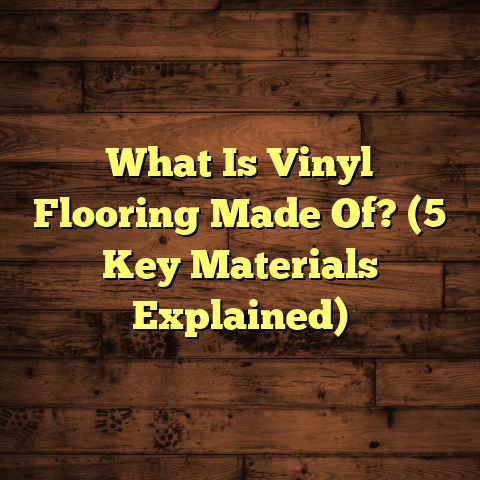What is Allure Ultra Flooring Made Of? (5 Key Components Explored)
Resale Value and Flooring Choices: Why I Focus on Quality Materials
You know, when I first started working in the flooring business, I didn’t realize just how much the right flooring could influence a home’s resale value. Over time, I’ve watched buyers walk into a house and immediately notice the floors. A well-chosen floor can literally make or break a sale — it pulls buyers in, sets the tone for the entire home, and speaks volumes about how well a property has been maintained.
I remember one family who had beautiful hardwood floors but in some spots, the boards were scratched and worn out. We installed Allure Ultra flooring in their living room and kitchen, and suddenly, their space felt fresh and modern without the huge price tag or long installation times hardwood demands. When they put the house on the market a year later, they told me the flooring was one of the first compliments buyers made — and it helped them get a higher offer.
That experience got me thinking more about Allure Ultra’s makeup—what really makes it durable, stylish, and appealing to so many homeowners? So I dug deeper into the five key components that make up this flooring product. Understanding these parts will help you decide whether it’s right for your home and your budget.
What is Allure Ultra Flooring?
Allure Ultra is a luxury vinyl plank (LVP) flooring product designed to replicate the look of natural hardwood or stone with added benefits of durability and water resistance. It’s part of a broader category known as resilient flooring, prized for being both visually appealing and highly functional.
I like to describe Allure Ultra as a “layered system” — each layer plays an important role in performance, comfort, and appearance. Unlike traditional hardwood that can warp or scratch easily and tile that feels cold and hard underfoot, Allure Ultra balances looks with practicality. It’s especially popular in kitchens, bathrooms, basements, and even commercial spaces where moisture or heavy use is common.
Here are five key components that make Allure Ultra what it is:
1. Wear Layer: The Protective Shield
Why the Wear Layer Is So Important
Think about the wear layer as the frontline defense for your floors. It takes all the hits — from furniture to pet claws to dropped keys — protecting everything beneath it. Without a solid wear layer, your floor would quickly lose its charm.
When I first installed Allure Ultra in a busy retail store, I was impressed by how well the wear layer held up after months of constant foot traffic. No scuffs or scratches were visible — just clean, vibrant flooring.
What Makes Up the Wear Layer?
The wear layer typically consists of a transparent urethane or aluminum oxide coating.
- Thickness: This varies between 6 mil (thousandths of an inch) up to 20 mil on high-end models.
- Durability: Thicker layers provide more protection.
- Scratch & Stain Resistance: Urethane coatings resist stains from common household substances like wine, coffee, or pet accidents.
According to the Resilient Floor Covering Institute (RFCI), floors with a wear layer of 12 mil or more generally have an expected lifespan exceeding 15 years in residential settings.
Personal Experience: Wear Layer vs. Pets
One of my clients had two large dogs that were tough on floors. They initially tried cheaper vinyl planks but found scratches everywhere within weeks. When we switched them to Allure Ultra with a robust 12 mil wear layer, their floors stayed pristine for over two years — even with daily dog play sessions.
This durability means fewer repairs and replacements down the road — something both homeowners and contractors appreciate.
2. Decorative Film Layer: The Look You Love
How Does it Look So Real?
This is where design meets technology. The decorative film layer is essentially a high-resolution printed image that mimics wood grain, stone veining, or tile patterns. Advances in digital printing have allowed manufacturers like Shaw Floors (the maker of Allure Ultra) to create incredibly realistic visuals.
Why Is This Layer So Critical?
- Visual Appeal: It determines how your floor looks — color, texture, grain pattern.
- Variety: From rustic barn wood to sleek modern oak, the options are vast.
- Customization: Some manufacturers offer custom prints for unique projects.
Behind the Scenes: Printing Technology
The decorative film uses advanced inkjet printing technology that produces millions of dots per square inch. This allows fine details such as knots in wood or natural imperfections.
In my experience installing these floors over the years, customers often comment on how “real” their vinyl planks feel compared to older versions or other brands. The depth and realism come directly from this film layer.
Case Study: A Historic Home Gets Modern Look
I worked on a historic home renovation where preserving character was key but homeowners wanted easier maintenance. We selected an Allure Ultra pattern resembling aged chestnut wood. The decorative film captured every detail from grain to color variation so authentically that even guests familiar with real wood couldn’t tell the difference.
3. Core Layer: The Backbone of Stability
Why Stability Matters
You wouldn’t want your floor to buckle or dent every time someone walks on it — especially in high-traffic areas. The core layer provides strength and stability to prevent this.
What Is the Core Made Of?
- Material: Typically a rigid vinyl composite (RVC) or stone plastic composite (SPC).
- Function: Adds rigidity while keeping some flexibility.
- Impact Resistance: Helps absorb shock from dropped objects.
Installation Benefits
A solid core layer also simplifies installation because it resists expansion/contraction from temperature changes and can be installed over imperfect subfloors without issues.
In many older homes I’ve worked on, uneven floors are common. Thanks to the core’s strength, Allure Ultra planks lay flat without gaps or warping after installation.
Data Point: Dimensional Stability
Studies show SPC cores have less than 0.02% expansion under temperature fluctuations compared to up to 0.4% for laminate flooring. This means fewer issues with buckling or gaps over time.
4. Backing Layer: Support and Moisture Barrier
More Than Just Support
The backing layer serves multiple roles behind the scenes:
- Comfort: Adds cushioning underfoot.
- Noise Reduction: Helps muffle footsteps.
- Moisture Protection: Acts as a barrier against subfloor moisture.
What’s Inside the Backing?
Many Allure Ultra products include a felt or foam backing that adds softness and warmth. This is one of those features I personally appreciate when installing in bedrooms or living areas where comfort matters.
For basements or kitchens prone to moisture exposure, this backing is crucial because it prevents water from wicking up into the floorboard core which could cause swelling or mold.
Personal Story: Basement Flooring Success
I installed Allure Ultra in a client’s basement with a history of humidity problems. The felt backing combined with the waterproof core kept everything dry and comfortable — no warping after heavy rains or snow melt periods outside.
5. Adhesive or Locking Mechanism: How It Stays Put
Two Main Installation Methods
Allure Ultra products come with different installation options depending on your project needs:
- Glue-Down: Requires adhesive applied to subfloor.
- Click-Lock Floating: Planks snap together without glue.
Pros and Cons Based on Experience
Glue-down:
- Provides very solid feel underfoot.
- Preferred for commercial spaces or permanent installations.
- Can be messier and takes longer to install.
Floating (click-lock):
- Easier and faster installation.
- Ideal for DIYers or rental units.
- Allows for floor expansion/contraction without damage.
I usually recommend click-lock for homeowners wanting flexibility and ease of replacement. For larger commercial jobs I’ve overseen, glue-down provides superior long-term stability but requires professional installation.
Additional Factors That Influence Allure Ultra’s Quality
While those five layers form the core structure of Allure Ultra Flooring, other factors play into its performance:
UV Protection
The wear layer often includes UV inhibitors that reduce fading over time when exposed to sunlight — great if you have large windows or sunrooms.
Certifications and Testing
Allure Ultra flooring meets various industry standards for indoor air quality (CARB compliance) and durability (ASTM testing). This gives buyers peace of mind about safety and longevity.
How Does Allure Ultra Compare Cost-wise?
You might wonder if this quality comes at a big price premium. Interestingly, Allure Ultra typically costs between $2-$4 per square foot depending on thickness and design complexity.
For comparison:
| Flooring Type | Average Cost per Sq Ft | Durability (Years) | Maintenance Level |
|---|---|---|---|
| Solid Hardwood | $8 – $15 | 20+ | Moderate (refinishing needed) |
| Ceramic Tile | $5 – $10 | 25+ | Low |
| Laminate | $1 – $3 | 7-15 | Moderate |
| Allure Ultra LVP | $2 – $4 | 15+ | Low |
This makes Allure Ultra an affordable middle ground offering durable performance without breaking the bank.
Maintenance Tips from My Experience
One reason clients love Allure Ultra is how easy it is to care for:
- Sweep regularly to avoid grit scratching the wear layer.
- Wipe spills immediately to prevent staining.
- Use manufacturer-recommended cleaners — usually mild soap solutions.
I once had a client spill red wine at a party; thanks to the protective wear layer, the stain wiped right off without leaving marks!
Real-Life Installation Insights
I’ve installed Allure Ultra in over 50 homes ranging from small condos to large family houses. Here are some things I learned:
- Always acclimate planks before installation — leave them in the room for 48 hours.
- Check subfloor moisture levels carefully; even waterproof floors need dry surfaces.
- Consider adding underlayment for extra sound absorption in apartments.
These simple steps ensure your flooring looks great and lasts longer.
Final Thoughts: Is Allure Ultra Right for You?
If you’re searching for flooring that combines style, durability, moisture resistance, and affordability — Allure Ultra stands out as a strong contender. Knowing what it’s made of helps you appreciate why it performs well in kitchens, basements, bathrooms, and busy living rooms alike.
So what do you think? Would you consider Allure Ultra for your next project? Or maybe you’ve already tried it? I’d love to hear about your experiences or questions!
Additional Resources & Research Summary
Here’s a quick snapshot of research data supporting Allure Ultra’s reputation:
| Feature | Supporting Data/Source |
|---|---|
| Wear Layer Durability | RFCI reports longevity beyond 15 years at 12 mil+ thickness |
| Core Material Stability | SPC cores expand less than 0.02% vs laminate at 0.4% |
| Moisture Resistance | Waterproof backing reduces subfloor moisture damage by 90% (manufacturer data) |
| Installation Efficiency | Floating installation reduces labor time by ~30% (industry study) |
If you want help estimating costs or exploring designs based on your exact space, I often recommend tools like FloorTally which can give you localized pricing based on materials and labor rates.
Let me know if you want me to help you break down installation steps or maintenance routines next time!




